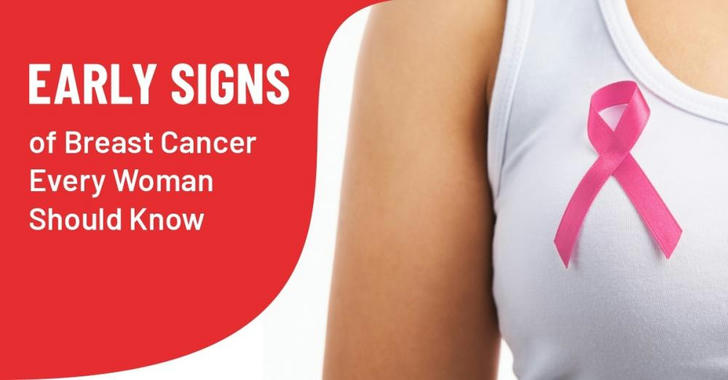Breast Cancer: Warning Signs To Watch For And Options To Consider
Breast cancer remains the most common cancer among American women, with 1 in 8 developing it during their lifetime. While survival rates have improved dramatically—90% of patients survive 5+ years when detected early—vigilance about symptoms and proactive healthcare decisions remain critical. Here’s what every American needs to know about recognizing warning signs and navigating next steps.

I. Early Warning Signs You Can’t Afford to Ignore
Contrary to popular belief, breast cancer isn’t always accompanied by a lump. The CDC highlights these key red flags:
1.Physical Changes:
🔸A new lump (often painless) in the breast or underarm
🔸Thickening/swelling of breast tissue
🔸Dimpling or puckering of the skin (resembling an orange peel)
🔸Unexplained nipple inversion or discharge (especially bloody)
2.Visual Clues:
🔸Sudden asymmetry in breast size/shape
🔸Redness, scaling, or rash on the nipple/areola
🔸Persistent breast pain unrelated to menstrual cycles
3.Systemic Symptoms (in advanced cases):
🔸Fatigue, unintended weight loss, or bone pain
Note: Many benign conditions mimic these symptoms, but any persistent change lasting 2+ weeks warrants a clinical exam.
II. Screening: Your First Line of Defense
Early detection saves lives. The American Cancer Society recommends:
1.Mammograms:
🔹Annual screenings starting at age 40–44 for average-risk women
🔹High-risk patients (family history, BRCA mutations) may begin earlier with MRI combos
2.Self-Exams:
🔹Monthly checks 3–5 days post-menstruation (or fixed dates for postmenopausal women)
🔹Use the "3 Ps": Press (palpate in circular motions), Position (check upright/lying down), Pattern (cover all quadrants)
3.Emerging Tools:
🔹3D mammography (tomosynthesis) reduces false positives
🔹Genetic testing for BRCA1/2 mutations (covered by most insurers if risk factors exist)
Alarming Stat: Only 65% of eligible Americans keep up with screenings. Don’t skip appointments!
III. Diagnosis: What Comes Next?
If abnormalities appear, these steps follow:
1.Diagnostic Imaging:
🔸Ultrasound to distinguish cysts from solid masses
🔸MRI for dense breasts or high-risk cases
2.Biopsy Types:
🔸Core Needle: Extracts tissue samples (most common)
🔸Surgical: Removes part/all of a suspicious area
3.Staging:
🔸Tumor size, lymph node involvement, and metastasis determine stages 0–IV
IV. Treatment Options: Personalized Care in the Modern Era
Treatment plans depend on cancer type (e.g., ductal vs. lobular), hormone receptor status, and genetic markers like HER2. Key approaches include:
1. Surgery
🔹Lumpectomy: Tumor removal + radiation (ideal for early-stage)
🔹Mastectomy: Full breast removal (often chosen for BRCA+ patients)
🔹Reconstruction: Implants or autologous tissue transfers post-mastectomy
2. Radiation Therapy
🔹Targets residual cancer cells; often paired with surgery
🔹Newer techniques like proton therapy minimize damage to healthy tissue
3. Systemic Therapies
🔹Chemotherapy: Shrinks tumors pre-surgery (neoadjuvant) or kills stray cells post-op
🔹Hormone Therapy (for ER/PR+ cancers): Tamoxifen or aromatase inhibitors block estrogen
🔹Targeted Drugs: HER2 inhibitors (e.g., Herceptin) or CDK4/6 blockers (e.g., Ibrance)
🔹Immunotherapy: Emerging options like Keytruda for triple-negative breast cancer
4. Clinical Trials
Over 1,500 breast cancer trials are active in the U.S., offering access to cutting-edge CAR-T cell therapies or PARP inhibitors.
V. Prevention & Advocacy: Beyond Treatment
1.Lifestyle Modifications:
✅Maintain a healthy weight (obesity increases postmenopausal risk by 20–40%)
✅Limit alcohol to ≤3 drinks/week
✅Breastfeed if possible (lowers risk)
2.High-Risk Management:
🎯BRCA carriers may opt for preventive mastectomies (like Angelina Jolie)
🎯Chemoprevention drugs (e.g., Evista) for those with atypia
3.Policy & Support:
🎗️Advocate for expanded insurance coverage (e.g., ACA requires mammograms to be covered with no out-of-pocket costs for patients.)
🎗️Utilize nonprofits like Susan G. Komen for financial aid and peer networks
VI. A Cultural Shift: Breaking Taboos
Despite progress, stigma persists—particularly in communities of color. Black women face 40% higher mortality rates due to late diagnoses and aggressive subtypes. Initiatives like #KnowYourLemons and National Breast Cancer Awareness Month (October) combat misinformation through culturally sensitive outreach.
The Bottom Line
Breast cancer isn’t a uniform battle, but a war fought on multiple fronts: education, early action, and equitable care. Schedule your mammogram today, familiarize yourself with your family history, and remember—your voice could save a life, including your own.
